Magnolia Swim Camp
The idea for these swim-focused pro camps started last year, and the first one happened in January 2015. Of the eight pro triathletes I coach on regular basis, I share coaching responsibilities for five of them with David Tilbury-Davis. I coach the swim and he coaches the bike and run. He lives in The Woodlands, and we thought it would be a great idea to bring everyone to town. I wrote a daily blog about it, and you can read it here.
The Woodlands, Texas is a terrific community for triathletes. The area also happens to be a great place to train for Kona. The heat and humidity are similar if not worse than Kona, there can be a lot of wind, and there are plenty of great places to run and ride. The swimming facilities are some of the best in the country. The community is very supportive of triathletes, especially those from out of town. For this camp, we had three pros from out of town and all of them had homestays for the month. Without the support of individuals and businesses (Sterling Ridge Orthopedics, Klean Athlete, Gold’s Gym, and Bicycle World) in the Woodlands/Magnolia communities, we would not be able to get this very focused and intense work done. I can’t thank everyone enough.
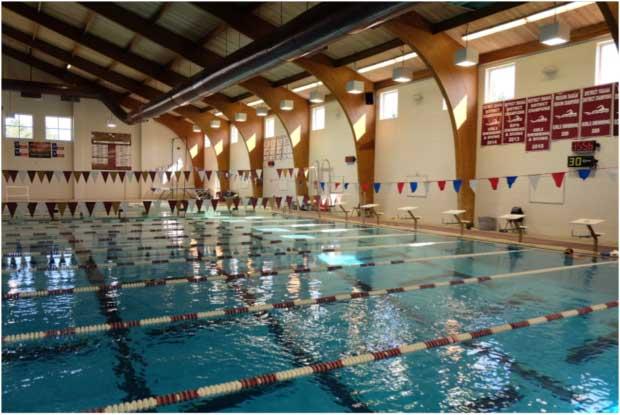
My focus when I built this team was to create the right culture and community for the athletes. It starts with the athlete, and ensuring that he has a clear goal and a clear idea about how to achieve that goal. To reinforce this model, I recruit ex-college swimmers to train with the pros. This year, I’ve been fortunate to get Mary Foster (former D1 college distance swimmer, marathon swimmer, and Magnolia Masters coach), Emily Finanger (former D1 college swimmer and former pro triathlete), Stephanie Terrell (former D1 college sprint swimmer) and Tim Monk (former D1 college swimmer and AG Kona qualifier). I have found it helpful to put experienced swimmers in the pool with triathletes.
We had our first big workout on Saturday, September 5 although the camp didn’t officially kick off until Tuesday the 8th. The pros that were in attendance on Saturday were Cody Beals, Balazs Csoke, Matt Hanson, and Lisa Roberts. Nils Frommhold was also in town and he joined in. Here’s the workout from Saturday:
Start of the Main Set (Bottom to Top: Beals, Hanson, Csoke, Frommhold, Finanger, Foster, Finanger)
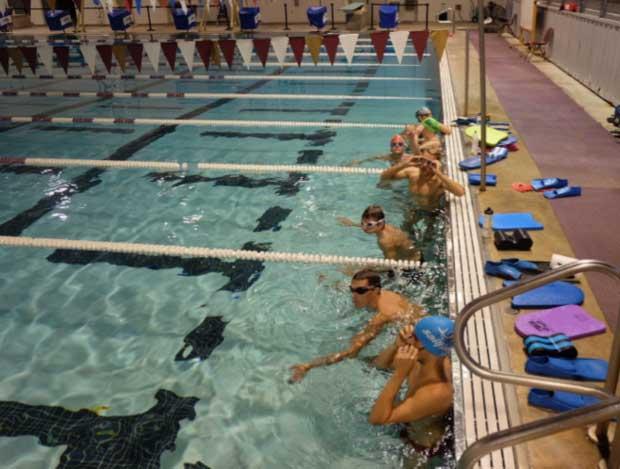
Warm up:
500 swim with fins
300 kick with fins
200 pull no paddles
4×100 descend 1-4 @ 1:20 (Cody, Balazs, Matt, Nils)/1:30 (Mary, Emily)
Total so far: 1400yd
Kick Set:
12×75 kick @ 1:30/1:40
Total so far: 2300yd
100 easy swim
Main set:
30×50 swim @ hold pace
Hold Pace:
Cody Beals – hold 31 @ 50
Balazs Csoke – hold 29 @ 50
Matt Hanson – hold 30 @ 50
Mary Foster – hold 33 @ 55
Emily Finanger – hold 33 @ 55
Lars Finanger – hold 33 @ 55
Results:
Cody – 31/32
Balazs – 28/29
Matt – 29/30
Mary – 32
Emily – 32
Lars – 31
So far: 3800yd
Warm down:
The goal of the "hold pace" sets is to swim at race pace with around 20 seconds of recovery for a prescribed distance. The original idea for these sets came from Brent Rushall and USRPT (Ultra Short Race Pace Training). We are training the stroke (the "kinetic chain") to swim at a certain pace. The biggest issue with regard to efficiency in swimming is the cost of drag.
For this set, the majority of the athletes paced around 1:00/100 or better for 1500 yards. In my experience, most triathlon coaches train the swim like the bike and run. This is one of the single biggest coaching misunderstandings in triathlon. If the majority of swim training is focused on "metabolics," then you are overlooking where the biggest gains in efficiency come from in swimming – the technique or the neuromuscular efficiency of the stroke movement. The primary objective of the workouts I prescribe is how to push more efficiency into the stroke. Swimming 10×400, 4×1000, or 3×1500 are the more popular swim workouts that that tri coaches prescribe, but all those workouts really do is train your stroke mechanics to move at a slower and less efficient pace. You are ingraining slow, sloppy technique. Overcoming drag through a more efficient movement/body position in the water is more important than training zones. I refer to it as training "technique under load," or swimming high intensity, short repeats while focusing on technique. In my experience, this is the best way to make triathletes more efficient in the water. Let me be clear, this is not an either/or proposition; I do consider metabolics, but is not the primary driver. The main focus is always, "How do we make the stroke more efficient?"
For this camp, and for the pros that are training for Kona, it's important to get as many sessions in the water as possible. In my experience, consistency trumps volume. You get a lot more out of your time in the water from five days a week for thirty minutes a day than you do from one and a half hours a day for three days a week. Again, it all comes back to promoting efficiency and "feel" for the water.
On Sunday, September 6 we did what I consider a "bridge" workout, where I am working with the athletes after some hard bike and run training, understanding that I won't be able to get a very hard swim out of them. I'm trying to "bridge" the "feel" for the water to the next day when they are less fatigued and we can have more productive results.
This is a modified workout that my club swimming coach, Dave Johnson, used to use as the standard daily warm-up and/or meet warm up. He called it the Alamo 2.0. I've modified it a little but kept the same basic outline. From a coaching perspective, there is a benefit to giving a standard warm-up everyday. It trains the body to warm up and then lets the coach and athlete see any variations in performance on a day-to-day basis.
Warm up:
400 swim w/fins
400 kick w/fins
400 pull no paddles
8×50 choice (swim/kick, drill, kick, swim, descend, etc.) @ 15 seconds rest interval
4×100 descend 1-4 @ 1:20/1:30/1:40 (different times based on ability levels in the pool)
2000 yards
At the end of this practice we played around with a new gadget that Magnolia Masters recently purchased. It's basically a "power meter" for the water. Over the last 9 months, I've been building a library of data on beginning triathletes through pros, ex-college swimmers and Olympic Trial Qualifiers. The results have been interesting and have led me to ask some questions about swimming and swim efficiency. Below are the results of three different athletes that I recently put on the "power rack." The first is a late thirties age group male triathlete that qualified for Kona 2 years ago, who swims between 1:05-1:10 for a full. The second set of data is from one of the fastest pro Ironman male swimmers. The third set of data is from a high school swimmer who recently qualified for US Olympic Trials in the 800m free. One insight that was confirmed by the "power rack" data was the importance of the kick. In the data posted below, the blue line represents the velocity of the swimmer measured every 60th of a second. The biggest negative impact on swimming efficiency comes from slowing down. If you slow down, the impact of drag on the efficiency of the stroke as you try to speed up again is substantial. The data shows that a good, efficient kick makes the trough of the blue line shallower and makes the overall swim more efficient. The kick limits the amount of deceleration of your overall velocity.
Age Group Triathlete =>
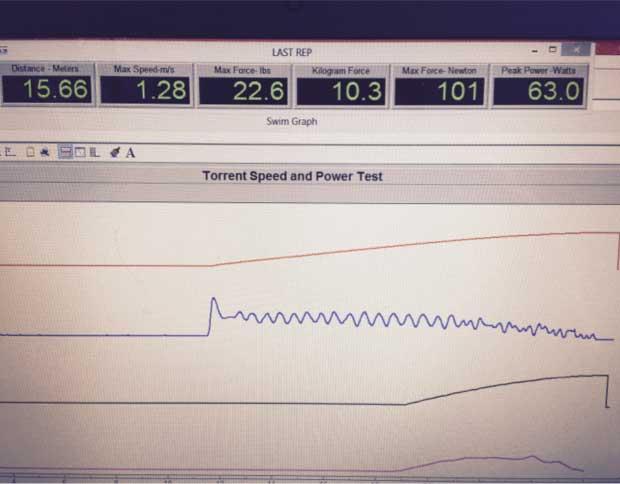
Pro Ironman Triathlete =>
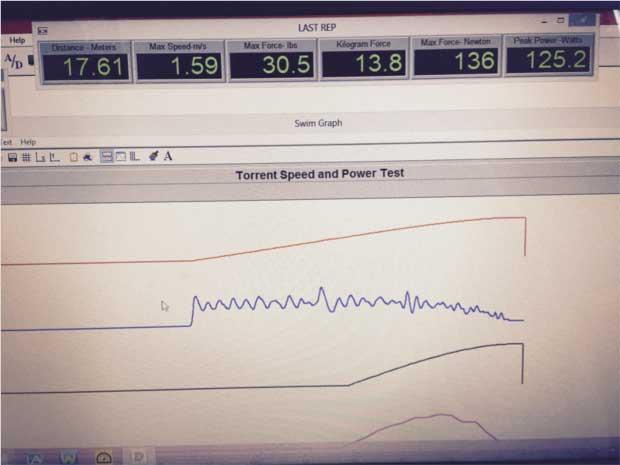
US Olympic Trials Qualifier (800m freestyler) =>
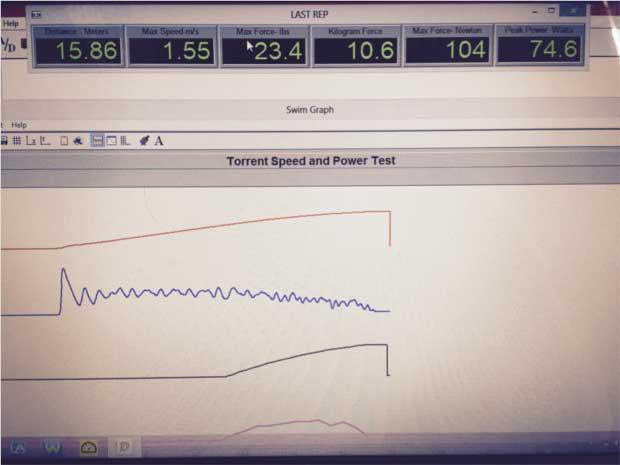
There is a lot of data to analyze, but the most important information consists of two numbers. The first number is the velocity from 5-10m (the second number at the top in meters per second). The second number is the peak power in watts (the last number to the far right). When you plot these numbers out, you can determine how efficient a swimmer is and whether or not stroke mechanics are translating the power generated into faster speeds, or if the mechanics are generating too much drag. Things really get interesting when you get a baseline on an athlete over time, and then start to fine-tune the training. But I'll write more about that later. The video below is the "power rack" in action, with pro triathlete Cody Beals as the guinea pig.
I'm a big fan of improving open water skills through racing. I am not a proponent of open water practice swims. For the most part, during a practice swim you are training the "kinetic chain" to go slower and be less efficient with slower technique. Open water skills are not as important as many believe; swim speed and efficiency can compensate for a multitude of sins in open water. To get faster, the majority of training should be efficient, clinical pool swimming.
Tuesday, September 8 was the first official day of the training camp. A group of German pros dropped in to swim as well, and we had a terrific dynamic. The pros in the water were Balazs, Caitlin, Cody, Lisa, Liz, and Matt. The German triathletes that dropped in included Nils Frommhold, Christian Kramer, Stefan Schmid, and Julia Gajer.
The workout =>
Warm up:
500 swim with fins
300 kick with fins
300 pull no paddles
4×100 descend 1-4 @ 1:20/1:30/1:40
So far: 1500yd
Kick set:
8×100 kick descend 1-4; ascend 5-8 @ 2:05/2:10/2:30
So far: 2300yd
100 easy swim
Main set:
60×25 swim @ hold pace
So far: 3800yd
Cody 13 @ 30
Matt 13 @ 30
Balazs 12 @ 30
Mary 14 @ 30
Liz 15 @ 30
Caitlin 16 @ 35
Lisa 16 @ 35
Everyone hit the hold paces. It was a tough set, but the swimmers kept their technique together and we were able to make slight corrections during the set and see if those changes translated into faster swims. To achieve the marginal gains that make a big difference in swimming, you always have to be tweaking the stroke and thinking about each and every stroke. There are no short cuts and it's never easy.
We took Wednesday off, and then Thursday the 10th was an active recovery workout, or long "bridge" workout. Fatigue from the week of swimming, biking, and running had built up so we kept it easy. Here is the workout we swam:
Warm up:
400 swim with fins
300 kick with fins
200 pull no paddles
4×100 descend 1-4 @ 1:20/1:30/1:40
So far: 1300yd
Main set (set is done continuous):
12×75 kick/swim (25k/50s) @ 1:20/1:30
12×50 pull no paddles @ 45/50/55
12×25 swim (1 fast / 1 easy) @ 35/40
So far: 3100yd
Friday's practice (typically a substantial workout) was cancelled due to thunderstorms, but we made up for it on Saturday the 12th at the Magnolia Pool.
Here was the workout for Saturday:
Warm up:
400 swim with fins
400 kick with fins
400 pull no paddles
8×50 descend 1-4; 5-8 @ 50
So far: 1600yd
Lead up:
12×50 kick @ 1:00/1:05/1:15
Break
12×25 mid pool sprints @ 45
So far: 2400yd
Main set:
20×100 swim @ hold pace
Hold Pace:
Balazs 1:02 @ 1:25
Cody 1:04 @ 1:25
Mary 1:08 @ 1:30
Liz 1:12 @ 1:30
Lisa 1:20 @ 1:40
Caitlin 1:19 @1:40
Results:
Balazs 1:01-1:02
Cody 1:05-1:06
Mary 1:07-1:08
Liz 1:11
Lisa 1:22
Caitlin 1:19
A high school distance swimmer joined the practice in the morning, which was great for pushing Balazs. The high school swimmer is a miler who goes about 16:30. On the set of 20×100, he held 0:58 @ 1:25. Here's a quick video of the two of them swimming together:
All in all, we got off to a solid start. Next week I'll try to ramp up the workload and see how much efficiency we can tease out of their strokes. Also, I'll be putting more of them on the "power rack" to get some additional data, and doing some one-on-one stroke analysis.
NOTES:
– Here's a good primer on USRPT training.
– If you want to read about other swimmers and coaches that are having success with USRPT-style training, check out this article written by my ex-team mate and two-time Olympian Josh Davis.



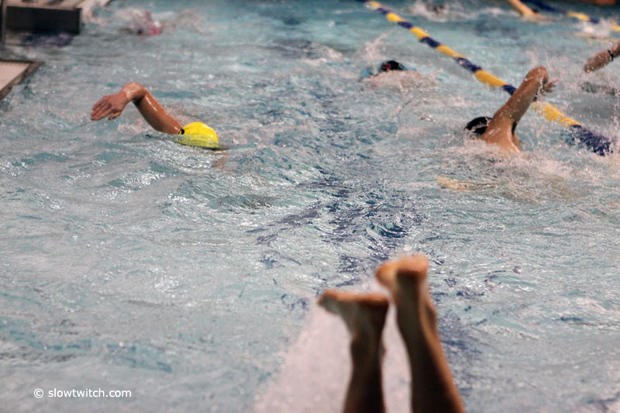
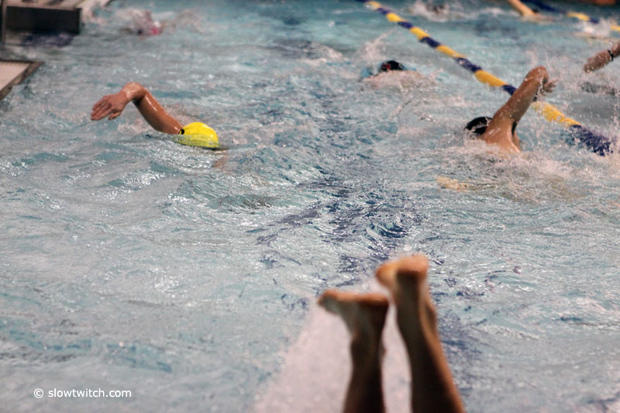

Start the discussion at forum.slowtwitch.com